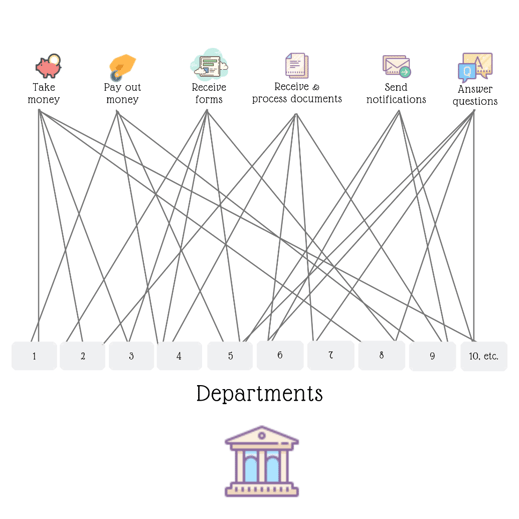All councils do things. The same things, over and over again. What things? Well, they all:
Take money (payments for services such as garden waste, parking permits etc)
Pay out money (payments for welfare benefits, rebates etc)
Receive forms (applications for things, questions)
Receive and process documents (as part of the above, or separately)
Send notifications (‘we have received’, ‘we are processing’ etc)
Answer questions (‘when is my bin collected, benefit paid etc?)

Not only do all councils do the same things, more or less, but it is also true that all departments in all councils do those same things. In any one council, there may be dozens of departments, and there are hundreds of local authorities. And they may be all doing things slightly differently, all with their own systems and software – an approach which might, if we were being kind, be described as, at the very least, inefficient.
Back in 2015, the director of the London Office of Technology & Innovation (LOTI) Eddie Copeland, then working for the Policy Exchange, imagined a scenario where local authorities would no longer design and/or buy their own online services – because those software services were essentially doing the same ‘things’ (see above) as in every other local authority. Instead, software services would be available in an ‘app store’, having been created by different organisations, and would be used by ‘dozens or even hundreds’, of local authorities. This would, because of economies of scale, be more efficient (i.e. cost-effective, saving councils money).
The ‘store’ Copeland described is available now from IEG4. Using a number of different technologies, IEG4 has formulated the concept of Local Government as a Platform, or LGaaP for short, which is essentially enabling local authorities to create ‘apps’ which they can share with other organisations and to pick and choose ‘apps’ which other organisations have created.
Our approach is that, whilst councils do like to do things their own way, which means there is, inevitably, some reinvention of the wheel going on – it is also true that more and more councils are happy to share. And through IEG4U, IEG4’s customer portal, they are able to make forms they’ve built for ‘things’ (see above) available for other councils to see, and share. Additionally, IEG4’s own free library of forms numbers around 100, which is also available to all customers on the portal. This means that, from day one, users have access to a library of in excess of 250 forms.
So, this really is ‘Council in a box’, and represents an opportunity for local authorities to make a step change forward with their digital strategies, wherever they are in the journey. This may be to get started on a coherent digital strategy, or to pull a number of disparate departmental approaches together. Because not only do councils get access to the forms, but also the forms share the same coherence, the same look and feel – making it easier for citizens accessing the council to recognise and navigate through a form. And if citizens find it easier to use online services, then channel shift, digital transformation, really does happen.
The tool used by the local authorities, eDesigner, also comes with the means to create trackable processes – a workflow/EDMS tool we call OpenProcess.
All of the forms share other benefits of eDesigner:
- All forms are mobile responsive and trackable
- Forms can be used in existing EDMS/workflow or with Open Process
- Forms can be tracked by citizens
- No code payment integration, including GOV.UK.Pay
- No code back office integration
- No code mapping integration
- Smart search tags make it easy to find forms
- Deploy a built service in seconds
So, for the things that all departments in all councils do, over and over again – the paying in and out, the tracking of requests, the receipt and sending of forms, the notifications etc etc – there is a store, a place where councils can share. It is IEG4’s LGaaP solution.

